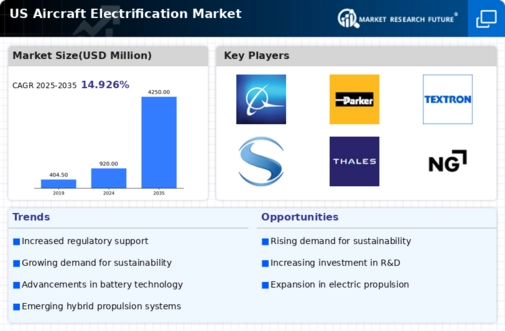The US Aircraft Electrification Market is rapidly evolving as a result of technological advancements, regulatory pressures, and the increasing need for sustainable aviation solutions. This market is characterized by a heightened focus on reducing carbon emissions and enhancing energy efficiency within the aviation sector. Key players are competitively positioning themselves by leveraging innovations in electric propulsion systems, battery technologies, and renewable energy sources. This competitive landscape is also shaped by collaborations between aerospace manufacturers and technology firms, as well as government initiatives aimed at promoting green aviation technologies.
As electrification becomes a central theme in aviation, companies are striving to establish a robust presence through strategic investments, partnerships, and research initiatives, contributing to an ecosystem that is focused on long-term sustainability goals while enhancing aircraft performance and operational efficiency.Raytheon Technologies stands out in the US Aircraft Electrification Market due to its commitment to innovation and a broad portfolio of aerospace technologies. With a rich history in defense and commercial aviation, the company leverages its expertise to develop advanced systems that contribute to fuel efficiency and reduced carbon emissions.
Raytheon Technologies enjoys significant market presence backed by its reputation for reliability and cutting-edge technology. Strengths in the market include its ability to integrate proprietary technologies into aircraft systems, enhancing overall performance and sustainability. Additionally, the company's focus on research and development enables it to stay at the forefront of electrification trends, allowing for quick adaptation to emerging opportunities and challenges in the electrified aviation space.Airbus is a key player in the US Aircraft Electrification Market, recognized for its strong focus on innovation and sustainability in aviation.
The company has made significant investments in electrification technologies, emphasizing the development of hybrid-electric and fully electric aircraft solutions. Airbus offers a range of key products and services that contribute to electrification, including electric propulsion systems and advanced battery technologies designed specifically for the aviation industry. The company has established a solid market presence within the US, driven by its commitment to pioneering eco-friendly aviation solutions. Airbus' strengths lie in its extensive research capabilities, a global network of industry partners, and a robust portfolio of commercial and military aircraft.
In recent years, the company has pursued strategic mergers and acquisitions to bolster its technology offerings, ensuring a continual drive towards electrification and broader sustainability goals in aviation within the US region.


















